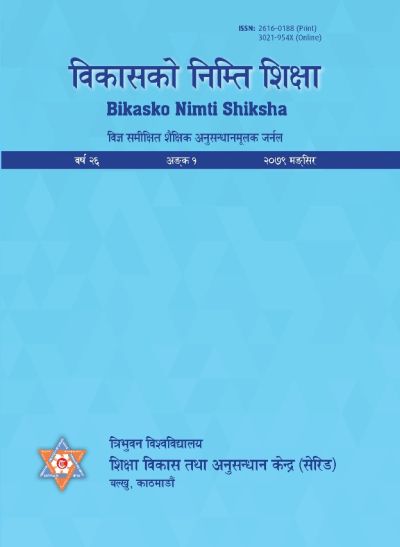नेपाली भाषा सिकाइमा कक्षा अन्तरक्रियाका प्रवृत्ति {Trends for Classroom Interaction in Nepali Language Learning}
DOI:
https://doi.org/10.3126/bns.v26i1.61444Keywords:
अन्तरक्रिया {interaction}, ज्ञानको निर्माण {construction of knowledge}, पूर्वानुमान {prediction}, पृष्ठभूमि {background}, सिकाइ वातावरण {learning environment}Abstract
प्रस्तुत अध्ययन नेपाली भाषा शिक्षणमा कक्षा अन्तरक्रियाको प्रयोगमा आधारित छ । अध्ययनमा माध्यमिक तहमा नेपाली विषयको शिक्षणमा प्रयोग गरिएका अन्तरक्रियाका ढाँचा तथा प्रवृत्तिहरूको पहिचान गरी तिनको उपयुक्तताको विश्लेषण गर्ने उद्देश्य राखिएको छ । कक्षा अवलोकन र गहन अन्तर्वार्ताको माध्यमबाट सङ्कलित तथ्याङ्कलाई फ्लेन्डरको कक्षा अन्तरक्रिया विश्लेषण श्रेणी पद्धति र भिगोत्स्कीको सामाजिक सांस्कृतिक सिद्धान्तका आधारमा विश्लेषण गरिएको छ । प्रस्तुत अध्ययनमा गुणात्मक निष्कर्षका लागि आंशिक रूपमा तथ्याङ्कशास्त्रीय आँकडाहरू पनि प्रयोग भएका छन् । तथ्याङ्कको विश्लेषण गर्दा नेपाली भाषा सिकाइका क्रममा विभिन्न ढाँचा तथा प्रवृत्तिका अन्तरक्रियाहरूको उपयोग गरिएको नतिजा प्राप्त भएको छ । सहभागी शिक्षकहरूले विषयको प्रस्तुतीकरणका क्रममा उत्पन्न परिस्थिति अनुसार अन्तरक्रियाका ढाँचाहरू अपनाएका छन् । सिपमा आधारित अन्तरक्रियाप्रति आवश्यक ख्याल पुर्याइएको छैन । शिक्षक विद्यार्थीहरूको आपसी सम्बन्ध, विद्यार्थीका भाषिक, पारिवारिक, आर्थिक, क्षमतागत पक्षहरूका आधारमा भाषिक ज्ञान, सिपको निर्माण हुने विश्वसनीय अवस्था देखिँदैन । भाषिक ज्ञान निर्माणका सम्बन्धमा कक्षा अन्तरक्रिया सबल नहुँदा नेपाली भाषाको सिकाइ उपलब्धि कमजोर बनेको छ । सिकाइलाई सिकारुको सामाजिक सांस्कृतिक पक्षसँग जोड्न सकेको खण्डमा अन्तरक्रियाको सही प्रयोग भई नयाँ ज्ञानको निर्माण गर्न सम्भव छ । सिकाइलाई योजनाबद्ध, सिकारुमुखी, अभ्यासमुखी बनाउन आवश्यक उपायहरू प्रस्तुत गरिएको यो अध्ययन नेपाली भाषा सिकाइका सन्दर्भमा उपयोगी सामग्री बन्ने छ ।
{The present study builds on the practices of classroom interaction in teaching the Nepali language. It aims at analyzing the appropriacy of interactions used while teaching Nepali at the secondary level by identifying the recurring patterns and tendencies. Flanders’ interaction analysis and Vygotsky's sociocultural theory have been applied to the analysis of the information gathered through the in-depth interviews and classroom observation. Also, a limited set of statistical data have been used in the study. Diverse patterns of interaction have been observed in the course of learning the Nepali language, wherein it has been found in the course of the study that the teachers exhibit adaptability in response to situational requirements. However, care has not been taken to interactions based on the skills. A reliable condition for the construction of students’ linguistic knowledge and skills based on the reciprocal relationship between the teacher and the students, and students’ linguistic, family, economic and proficiency-based aspects cannot be observed. Because the classroom interaction in relation to the construction of linguistic knowledge is not strong, the learning achievement in the Nepali language has been weaker. Therefore, it is possible to construct new knowledge provided that the learning is linked with the learners’ socio-cultural aspects because it leads to the suitable use of interaction. It is expected that this study, which presents the ways required for getting learning well-planned, student-centered and practice-oriented, will be a useful resource in the context of learning the Nepali language.}
Downloads
Downloads
Published
How to Cite
Issue
Section
License
Copyright (c) 2022 Author

This work is licensed under a Creative Commons Attribution-NonCommercial 4.0 International License.




